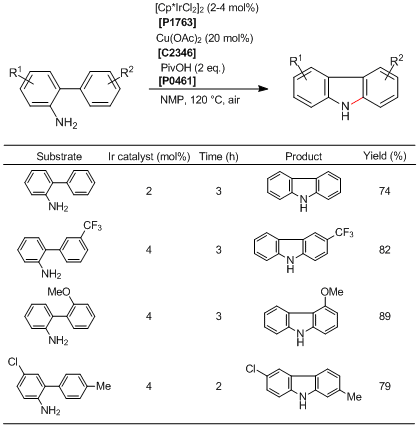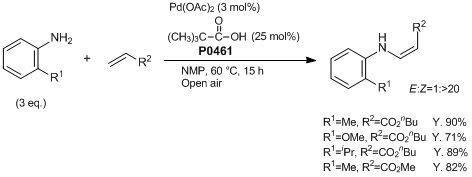Published TCIMAIL newest issue No.197
Maximum quantity allowed is 999
Please select the quantity
CAS RN: 75-98-9 | Product Number: P0461
Pivalic Acid

Purity: >99.0%(GC)
Synonyms:
- 2,2-Dimethylpropionic Acid
- Trimethylacetic Acid
Product Documents:
| Size | Unit Price | Belgium | Japan* | Quantity |
|---|---|---|---|---|
| 25G |
€16.00
|
7 | ≥100 |
|
| 100G |
€24.00
|
6 | ≥100 |
|
| 400G |
€43.00
|
7 | 19 |
|
*Stock available in Belgium will be delivered in 1 to 3 days
*Stock available in Japan will be delivered in 1 to 2 weeks (excludes regulated items and dry ice shipments).
| Product Number | P0461 |
| Purity / Analysis Method | >99.0%(GC) |
| Molecular Formula / Molecular Weight | C__5H__1__0O__2 = 102.13 |
| Physical State (20 deg.C) | Solid |
| Storage Temperature | Room Temperature (Recommended in a cool and dark place, <15°C) |
| CAS RN | 75-98-9 |
| Reaxys Registry Number | 969480 |
| PubChem Substance ID | 87574655 |
| SDBS (AIST Spectral DB) | 3139 |
| Merck Index (14) | 7511 |
| MDL Number | MFCD00004194 |
Specifications
| Appearance | White or Colorless to Almost white or Almost colorless powder to lump to clear liquid |
| Purity(GC) | min. 99.0 % |
| Purity(Neutralization titration) | min. 98.0 % |
| Freezing point | 32.0 to 36.0 °C |
Properties (reference)
| Melting Point | 34 °C |
| Boiling Point | 164 °C |
| Solubility in water | Slightly soluble |
| Degree of solubility in water | 25 g/l 20 °C |
GHS
| Pictogram |



|
| Signal Word | Danger |
| Hazard Statements | H302 + H312 : Harmful if swallowed or in contact with skin. H314 : Causes severe skin burns and eye damage. H371 : May cause damage to organs. H290 : May be corrosive to metals. |
| Precautionary Statements | P260 : Do not breathe dust. P280 : Wear protective gloves/ protective clothing/ eye protection/ face protection/ hearing protection. P303 + P361 + P353 : IF ON SKIN (or hair): Take off immediately all contaminated clothing. Rinse skin with water. P301 + P330 + P331 : IF SWALLOWED: Rinse mouth. Do NOT induce vomiting. P304 + P340 + P310 : IF INHALED: Remove person to fresh air and keep comfortable for breathing. Immediately call a POISON CENTER/doctor. P305 + P351 + P338 + P310 : IF IN EYES: Rinse cautiously with water for several minutes. Remove contact lenses, if present and easy to do. Continue rinsing. Immediately call a POISON CENTER/doctor. |
Related Laws:
| EC Number | 200-922-5 |
| RTECS# | TO7700000 |
Transport Information:
| UN Number | UN3261 |
| Class | 8 |
| Packing Group | II |
| HS Number | 2915907098 |
Application
Synthesis of N―H Carbazoles via Ir-catalyzed Intramolecular C―H Amination

Typical Procedure:
To a 20 mL two-necked flask with a reflux condenser and a rubber cap are added 2-aminobiphenyls (0.5 mmol), [Cp*IrCl2]2 (0.01 mmol, 8.0 mg), Cu(OAc)2 (0.1 mmol, 18 mg), pivalic acid (1 mmol, 102 mg), 1-methylnaphthalene (ca. 30 mg) as an internal standard, and N-methyl-2-pyrrolidone (NMP, 3 mL). Then, the resulting mixture is stirred under air at 120 °C for 3-6 h. After cooling, the reaction mixture is extracted with ethyl acetate (100 mL). The organic layer is washed by aqueous NaHCO3 (100 mL×3), and dried over Na2SO4. After evaporation of the solvents under vacuum, the product is isolated by column chromatography on silica gel using hexane-ethyl acetate (10:1) as the eluent.
To a 20 mL two-necked flask with a reflux condenser and a rubber cap are added 2-aminobiphenyls (0.5 mmol), [Cp*IrCl2]2 (0.01 mmol, 8.0 mg), Cu(OAc)2 (0.1 mmol, 18 mg), pivalic acid (1 mmol, 102 mg), 1-methylnaphthalene (ca. 30 mg) as an internal standard, and N-methyl-2-pyrrolidone (NMP, 3 mL). Then, the resulting mixture is stirred under air at 120 °C for 3-6 h. After cooling, the reaction mixture is extracted with ethyl acetate (100 mL). The organic layer is washed by aqueous NaHCO3 (100 mL×3), and dried over Na2SO4. After evaporation of the solvents under vacuum, the product is isolated by column chromatography on silica gel using hexane-ethyl acetate (10:1) as the eluent.
References
Application
Pd-Catalyzed Z-Selective Oxidative Amination of Olefins

Typical Procedure:
A mixture of butyl acrylate (128 mg, 1.0 mmol) and o-toluidine (322 mg, 3.0 mmol) is allowed to react with Pd(OAc)2 (6.7 mg, 0.03 mmol, 3 mol%) and pivalic acid (26 mg, 0.25 mmol) in NMP (0.5 mL) at 60 °C for 15 h under open air in a 30 mL round-bottomed flask. The crude reaction mixture is cooled to room temperature. EtOAc (30 mL) is added to the dark solution. The residue is purified by column chromatography on silica gel (EtOAc : Hexane = 1 : 40) to provide (Z)-butyl 3-(o-tolylamino)acrylate (210 mg, Y. 90%).
A mixture of butyl acrylate (128 mg, 1.0 mmol) and o-toluidine (322 mg, 3.0 mmol) is allowed to react with Pd(OAc)2 (6.7 mg, 0.03 mmol, 3 mol%) and pivalic acid (26 mg, 0.25 mmol) in NMP (0.5 mL) at 60 °C for 15 h under open air in a 30 mL round-bottomed flask. The crude reaction mixture is cooled to room temperature. EtOAc (30 mL) is added to the dark solution. The residue is purified by column chromatography on silica gel (EtOAc : Hexane = 1 : 40) to provide (Z)-butyl 3-(o-tolylamino)acrylate (210 mg, Y. 90%).
References
PubMed Literature
Articles/Brochures
TCIMAIL
[Research Articles] Synthesis of N-H Carbazoles via Ir-catalyzed Intramolecular C-H Amination[Research Articles] Pd-Catalyzed Z-Selective Oxidative Amination of Olefins
Product Documents (Note: Some products will not have analytical charts available.)
Safety Data Sheet (SDS)
Please select Language.
The requested SDS is not available.
Please Contact Us for more information.
Specifications
C of A & Other Certificates
Please enter Lot Number
Incorrect Lot Number. Please input only the 4-5 alphanumeric characters before the hyphen.
Sample C of A
This is a sample C of A and may not represent a recently manufactured lot of the product.
A sample C of A for this product is not available at this time.
Analytical Charts
Please enter Lot Number
Incorrect Lot Number. Please input only the 4-5 alphanumeric characters before the hyphen.
The requested analytical chart is not available. Sorry for the inconvenience.





